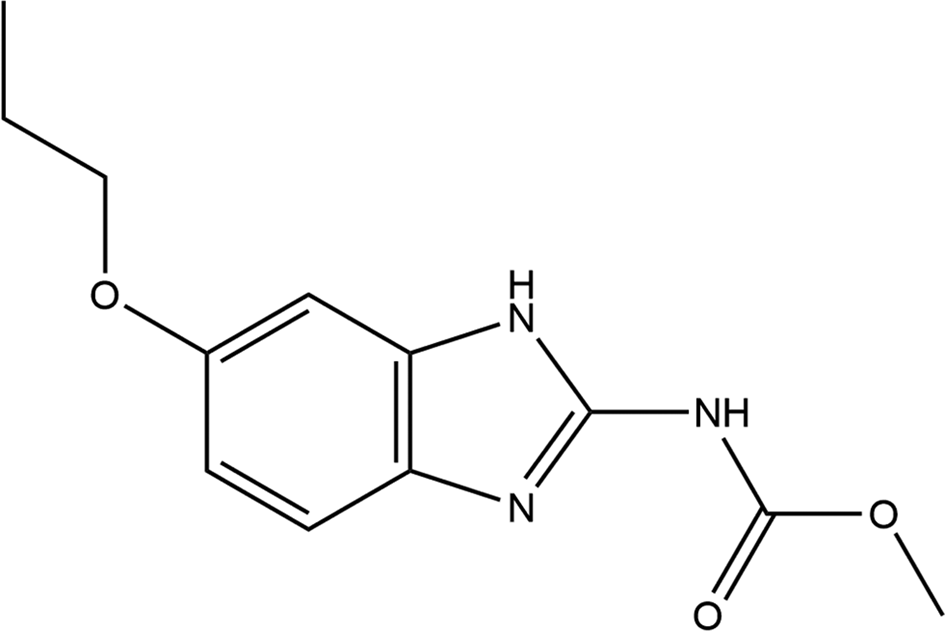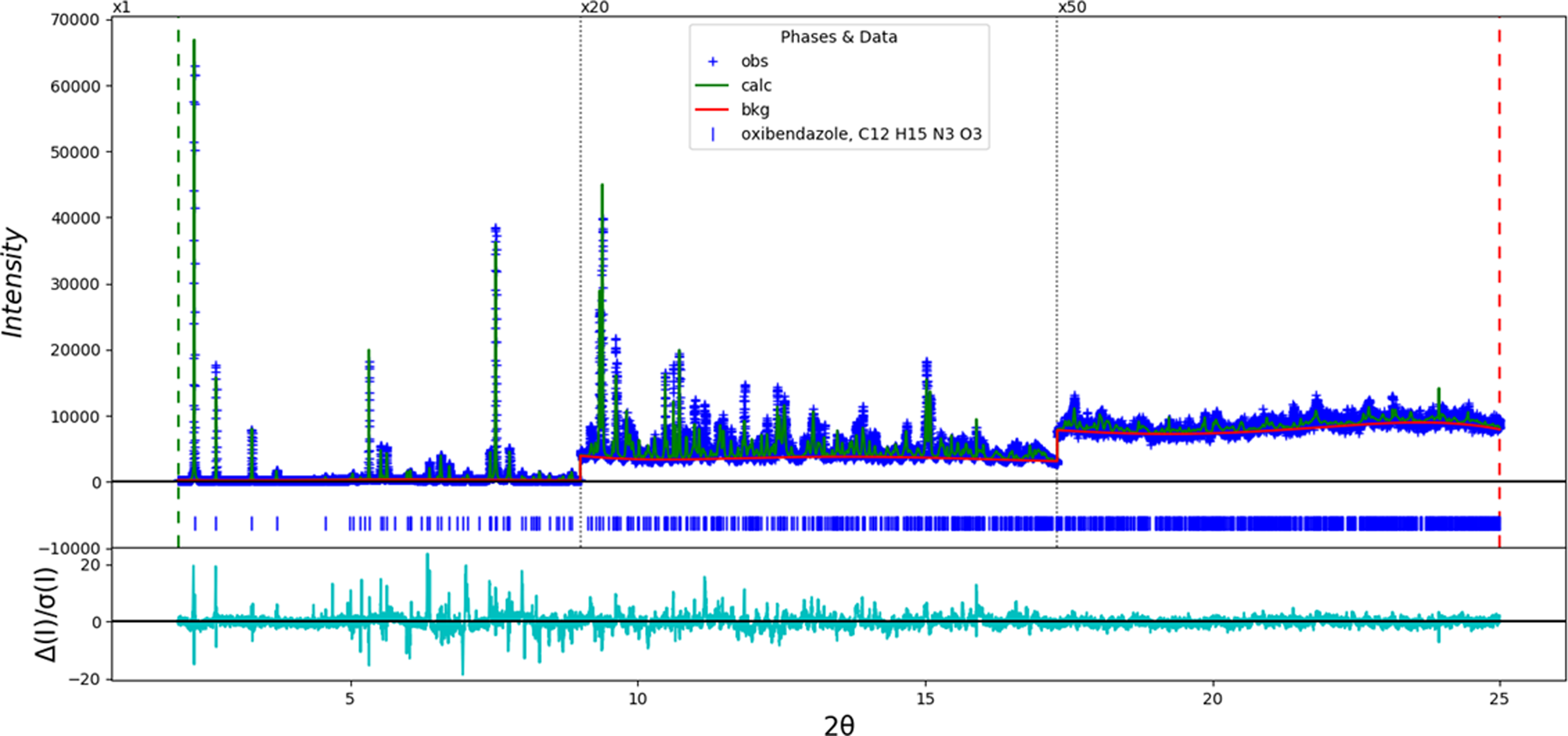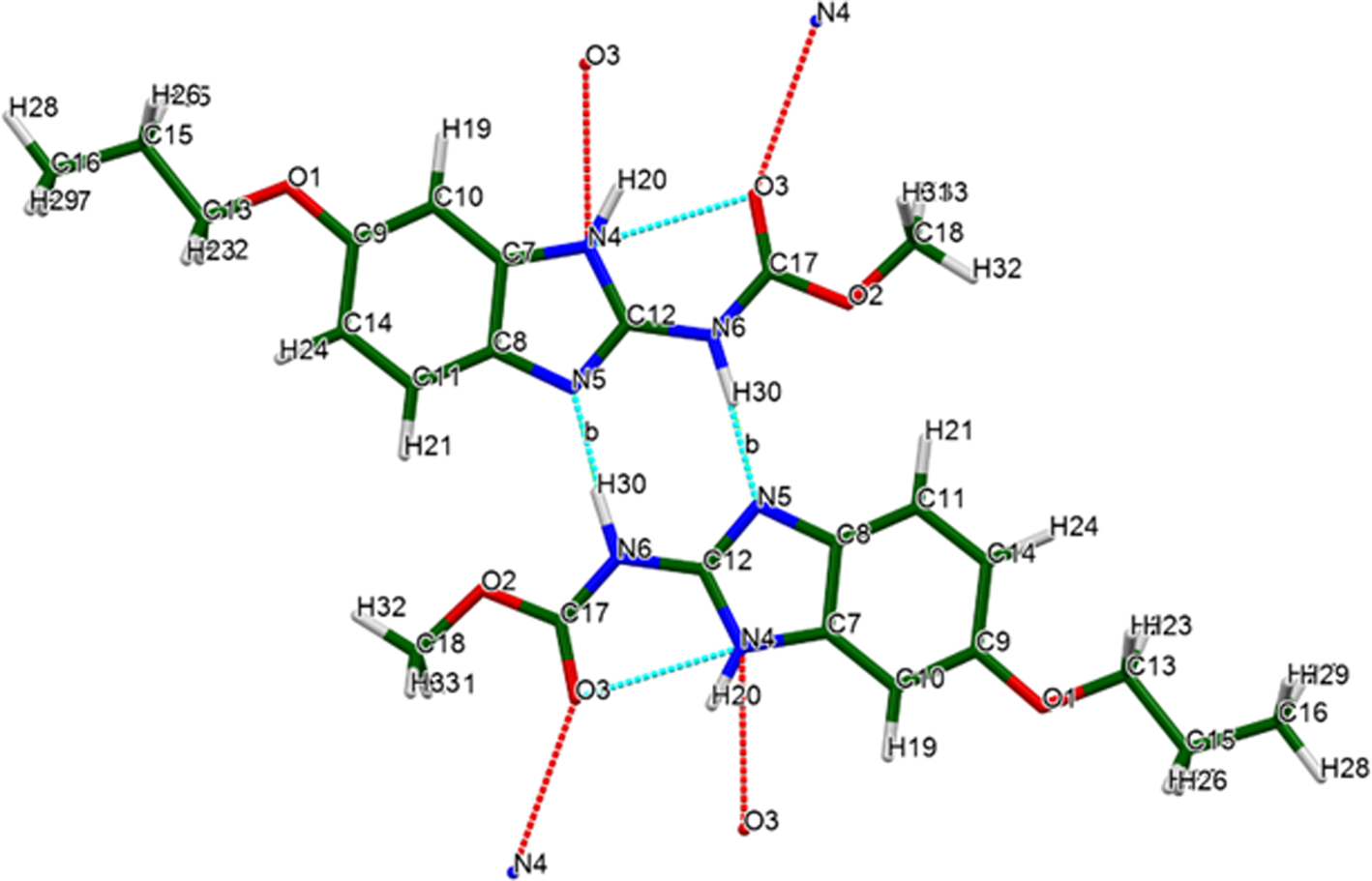I. INTRODUCTION
Oxibendazole (sold under the brand name Loditac among others) is used to protect against roundworms, threadworms, pinworms, and lungworm infestations in horses and some domestic pets. The systematic name (CAS Registry Number 20559-55-1) is methyl N-(6-propoxy-1H-benzimidazol-2-yl)carbamate. A two-dimensional molecular diagram is shown in Figure 1. As is the case with some other veterinary pharmaceuticals, we are unaware of any published X-ray powder diffraction data for this compound.

Figure 1. The 2D molecular structure of oxibendazole.
This work was carried out as part of a project (Kaduk et al., Reference Kaduk, Crowder, Zhong, Fawcett and Suchomel2014) to determine the crystal structures of large-volume commercial pharmaceuticals, and include high-quality powder diffraction data for them in the Powder Diffraction File (Gates-Rector and Blanton, Reference Gates-Rector and Blanton2019).
II. EXPERIMENTAL AND REFINEMENT
Oxibendazole was a commercial reagent, purchased from TargetMol (Batch #143644), and was used as-received. The white/cream powder was packed into a 1.5 mm diameter Kapton capillary and rotated during the measurement at ~50 Hz. The powder pattern was measured at 295 K at beamline 11-BM (Antao et al., Reference Antao, Hassan, Wang, Lee and Toby2008; Lee et al., Reference Lee, Shu, Ramanathan, Preissner, Wang, Beno, Von Dreele, Lynn, Charles, Sytle, Xuesong and Brian2008; Wang et al., Reference Wang, Toby, Lee, Ribaud, Antao, Kurtz, Ramanathan, Von Dreele and Beno2008) of the Advanced Photon Source at Argonne National Laboratory using a wavelength of 0.458200(2) Å from 0.5 to 50° 2θ with a step size of 0.001°, and a counting time of 0.1 s step−1. The high-resolution powder diffraction data were collected using twelve silicon crystal analyzers that allow for high angular resolution, high precision, and accurate peak positions. A mixture of silicon (NIST SRM 640c) and alumina (NIST SRM 676a) standards (ratio Al2O3:Si = 2:1 by weight) was used to calibrate the instrument and refine the monochromatic wavelength used in the experiment.
The pattern was difficult to index, but a reasonable unit cell (volume corresponding to an integral number of molecules) was obtained using N-TREOR (Altomare et al., Reference Altomare, Cuocci, Giacovazzo, Moliterni, Rizzi, Corriero and Falcicchio2013). A monoclinic cell with a = 23.199, b = 5.3497, c = 19.8957 Å, β = 97.061°, V = 2450.5 Å3, and Z = 8 was obtained. The systematic absences corresponded to space groups Cc or C2/c. Since the volume of the unit cell corresponded to 8 molecules, space group C2/c was assumed, and confirmed by successful solution and refinement of the structure. A reduced cell search in the Cambridge Structural Database (Groom et al., Reference Groom, Bruno, Lightfoot and Ward2016) yielded no hits. A few weak (<0.5% relative intensity) were not indexed by this cell, so the sample seems to contain at least one impurity phase.
An oxibendazole molecule was downloaded as Conformer3D_CID_4622.sdf from PubChem (Kim et al., Reference Kim, Chen, Cheng, Gindulyte, He, He, Li, Benjamin, Paul, Bo, Leonid, Jian and Evan2019). The file was converted to a *.mol2 file using Mercury (Macrae et al., Reference Macrae, Sovago, Cottrell, Galek, McCabe, Pidcock, Platings, Greg, Joanna, Matthew and Peter2020). The structure was solved using Monte Carlo simulated annealing techniques as implemented in DASH (David et al., Reference David, Shankland, Van De Streek, Pidcock, Samuel Motherwell and Cole2006), including a (010) preferred orientation coefficient. Seven of the 100 runs yielded cost factors much lower than the others. The best solution was selected for refinement. Equivalent solutions were also obtained using EXPO2014 (Altomare et al., Reference Altomare, Cuocci, Giacovazzo, Moliterni, Rizzi, Corriero and Falcicchio2013).
Rietveld refinement was carried out using GSAS-II (Toby and Von Dreele, Reference Toby and Von Dreele2013). Only the 2.0–25.0° portion of the pattern was included in the refinement (d min = 1.058 Å). All non-H bond distances and angles were subjected to restraints, based on a Mercury/Mogul Geometry Check (Bruno et al., Reference Bruno, Cole, Kessler, Luo, Sam Motherwell, Purkis, Smith, Taylor, Cooper, Harris and Guy Orpen2004; Sykes et al., Reference Sykes, McCabe, Allen, Battle, Bruno and Wood2011). The Mogul average and standard deviation for each quantity were used as the restraint parameters, but the standard deviations of the bond distances and angles in the propoxy side chain were decreased to 0.03 Å and 3.0°. The restraints contributed 9.0% to the final χ 2. The initial model contained a small void on a twofold axis at approximately 0,0.24,1/4. Including an oxygen atom (water molecule) at this position resulted in a negative occupancy, so the atom was removed. The U iso of the atoms in the propoxy side chain refined to very large values (>0.3 Å2), suggesting the possibility of disorder. The propoxy chain was thus modeled as a superposition of two orientations. The occupancies refined to 51/49%. The hydrogen atoms were included in calculated positions, which were recalculated during the refinement using Materials Studio (Dassault, 2021). The U iso of the heavy atoms were grouped by chemical similarity. The U iso for the H atoms were fixed at 1.3× the U iso of the heavy atoms to which they are attached. A fourth-order spherical harmonic model was included in the refinement. The refined texture index was 1.044(1). The peak profiles were described using the Stephens (Reference Stephens1999) generalized microstrain model. Initial refinements used a uniaxial (010) microstrain model. When the microstrain model was switched to generalized, the residuals decreased, but the refinement eventually diverged (even using a Jacobian rather than a Hessian least squares matrix). In the final refinement, the Shkl coefficients were fixed at the values which yielded the best fit before divergence. The background was modeled using a 6-term shifted Chebyshev polynomial, and a peak at 5.48° 2θ to model the scattering from the Kapton capillary and any amorphous component.
The final refinement of 86 variables using 23 037 observations and 51 restraints yielded the residuals R wp = 0.1291 and GOF = 2.47. The largest peak (1.19 Å from C14) and hole (1.62 Å from N4) in the difference Fourier map were 0.64(13) and –0.55(13) eÅ–3, respectively. The largest errors in the difference plot (Figure 2) are in the shapes and intensities of some of the strong low-angle peaks, and reflect the imperfect profile model and the impurity peaks.

Figure 2. The Rietveld plot for the refinement of oxibendazole. The blue crosses represent the observed data points, and the green line is the calculated pattern. The cyan curve is the normalized error plot, and the red line is the background curve. The vertical scale has been multiplied by a factor of 20× for 2θ > 9.0°, and by 50× for 2θ > 17.3°. The row of blue tick marks indicates the calculated reflection positions of oxibendazole.
The crystal structure of an ordered model of oxibendazole, with one orientation of the propoxy side chain, was optimized using VASP (Kresse and Furthmüller, Reference Kresse and Furthmüller1996) (fixed experimental unit cell) through the MedeA graphical interface (Materials Design, 2016). The calculation was carried out on 16 2.4 GHz processors (each with 4 GB RAM) of a 64-processor HP Proliant DL580 Generation 7 Linux cluster at North Central College. The calculation used the GGA-PBE functional, a plane wave cutoff energy of 400.0 eV, and a k-point spacing of 0.5 Å−1 leading to a 5 × 1 × 5 mesh, and took ~44 h. A single-point density functional theory calculation (fixed experimental cell) and population analysis were carried out using CRYSTAL17 (Dovesi et al., Reference Dovesi, Erba, Orlando, Zicovich-Wilson, Civalleri, Maschio, Rérat, Silvia, Jacopo, Simone and Bernard2018). The basis sets for the H, C, N, and O atoms in the calculation were those of Gatti et al. (Reference Gatti, Saunders and Roetti1994). The calculations were run on a 3.5 GHz PC using 8 k-points and the B3LYP functional, and took ~1.5 h.
III. RESULTS AND DISCUSSION
The root-mean-square (rms) Cartesian displacement between the Rietveld-refined and DFT-optimized structures of the oxibendazole molecule is 0.217 Å (Figure 3); the maximum difference is 0.569 Å at the methyl group C16 at the end of the propoxy chain. The agreement is within the normal range for correct structures (van de Streek and Neumann, Reference van de Streek and Neumann2014). Because the DFT optimization required an ordered structure, only one of the two orientations of the propoxy chain was used (the one with the lower atom numbers: C13, C15, and C16). The apparent void in the experimental structure disappeared on DFT optimization. The void was located near the propoxy chains and may provide a reason for the apparent disorder. This discussion concentrates on the DFT-optimized structure. The asymmetric unit (with atom numbering) is illustrated in Figure 4. The displacement coefficients of the disordered chain are much larger than those in the rest of the molecule, consistent with the disorder. The best view of the crystal structure is down the short b-axis (Figure 5). The structure consists of hydrogen-bonded layers of planar molecules parallel to the bc-plane. The propoxy groups lie on the outer surfaces of the layers. The mean planes of the benzimidazole ring systems are approximately (510) and (5-10). The Aromatics Analyser module of Mercury indicates only two moderate-strength interactions; one of 5.35 Å along the b-axis, and the other of 6.60 Å within the hydrogen-bonded layers.

Figure 3. Comparison of the Rietveld-refined (red) and VASP-optimized (blue) structures of oxibendazole. The rms Cartesian displacement is 0.217 Å. Image generated using Mercury (Macrae et al., Reference Macrae, Sovago, Cottrell, Galek, McCabe, Pidcock, Platings, Greg, Joanna, Matthew and Peter2020).

Figure 4. The asymmetric unit of oxibendazole, with the atom numbering. The atoms are represented by 50% probability spheroids/ellipsoids. Image generated using Mercury (Macrae et al., Reference Macrae, Sovago, Cottrell, Galek, McCabe, Pidcock, Platings, Greg, Joanna, Matthew and Peter2020).

Figure 5. The crystal structure of oxibendazole, viewed down the b-axis. Image generated using Diamond (Crystal Impact, Reference Putz and Brandenburg2022).
All of the bond distances, bond angles, and torsion angles fall within the normal ranges indicated by a Mercury/Mogul Geometry Check (Macrae et al., Reference Macrae, Sovago, Cottrell, Galek, McCabe, Pidcock, Platings, Greg, Joanna, Matthew and Peter2020). Quantum chemical geometry optimization of the isolated oxibendazole molecule (DFT/B3LYP/6-31G*/water) using Spartan ‘18 (Wavefunction, 2020) indicated that the observed conformation of the first orientation (lower atom numbers) is the minimum-energy conformation. Both orientations of the propoxy group converged to the same local minimum. The relatively-loose packing of the propoxy groups (few short contacts) is consistent with the apparent disorder of these groups.
Analysis of the contributions to the total crystal energy of the structure using the Forcite module of Materials Studio (Dassault, 2021) suggests that the intramolecular deformation energy is dominated by angle deformation terms, as expected for a fused ring system. The intermolecular energy is dominated by van der Waals and electrostatic attractions, which in this force field analysis also include hydrogen bonds. The hydrogen bonds are better analyzed using the results of the DFT calculation.
Hydrogen bonds are prominent in the structure (Table I). Strong N6–H30⋯N5 hydrogen bonds link the molecules into dimers (Figure 6), with a graph set (Etter, Reference Etter1990; Bernstein et al., Reference Bernstein, Davis, Shimoni and Chang1995; Shields et al., Reference Shields, Raithby, Allen and Samuel Motherwell2000) R2,2(8). N4–H20⋯O3 hydrogen bonds further link these dimers into layers parallel to the bc-plane. The energy of the N–H⋯O hydrogen bond was calculated using the correlation of Wheatley and Kaduk (Reference Wheatley and Kaduk2019). C–H⋯O hydrogen bonds also contribute to the lattice energy.

Figure 6. The oxibendazole dimers, generated by the strong N–H⋯N hydrogen bonds. Image generated using Mercury (Macrae et al., Reference Macrae, Sovago, Cottrell, Galek, McCabe, Pidcock, Platings, Greg, Joanna, Matthew and Peter2020).
TABLE I. Hydrogen bonds (CRYSTAL17) in oxibendazole.

The volume enclosed by the Hirshfeld surface of oxibendazole (Figure 7; Spackman et al., Reference Spackman, Turner, McKinnon, Wolff, Grimwood, Jayatilaka and Spackman2021) is 299.30 Å3, 97.77% of 1/8 the unit cell volume. The packing density is thus fairly typical. The only significant close contacts (red in Figure 7) involve the hydrogen bonds. The average volume/non-hydrogen atom is 17.0 Å3.

Figure 7. The Hirshfeld surface of oxibendazole. Intermolecular contacts longer than the sums of the van der Waals radii are colored blue, and contacts shorter than the sums of the radii are colored red. Contacts equal to the sums of radii are white. Image generated by CrystalExplorer 21.5 (Spackman et al., Reference Spackman, Turner, McKinnon, Wolff, Grimwood, Jayatilaka and Spackman2021).
The Bravais–Friedel–Donnay–Harker (Bravais, Reference Bravais1866; Friedel, Reference Friedel1907; Donnay and Harker, Reference Donnay and Harker1937) morphology suggests that we might expect elongated morphology for oxibendazole, with [010] as the unique axis. A fourth-order spherical harmonic model was included in the refinement. The texture index was 1.044(1), indicating that preferred orientation was small in this rotated capillary specimen.
IV. DEPOSITED DATA
The powder pattern of oxibendazole from this synchrotron data set has been submitted to ICDD for inclusion in the Powder Diffraction File. The Crystallographic Information Framework (CIF) files containing the results of the Rietveld refinement (including the raw data) and the DFT geometry optimization were deposited with the ICDD. The data can be requested at pdj@icdd.com.
ACKNOWLEDGEMENTS
The use of the Advanced Photon Source at Argonne National Laboratory was supported by the U.S. Department of Energy, Office of Science, Office of Basic Energy Sciences, under Contract No. DE-AC02-06CH11357. This work was partially supported by the International Centre for Diffraction Data. We thank Lynn Ribaud and Saul Lapidus for their assistance in the data collection.
CONFLICT OF INTEREST
The authors have no conflict of interest to declare.













